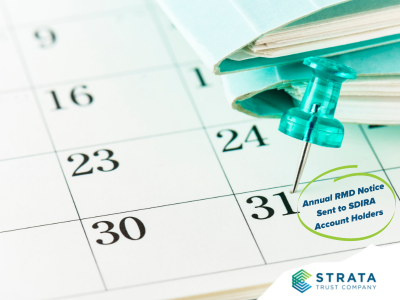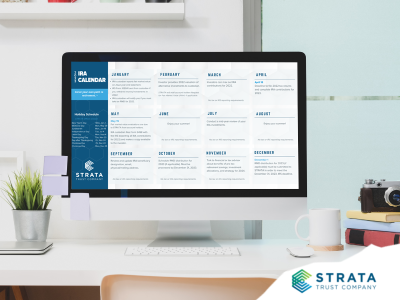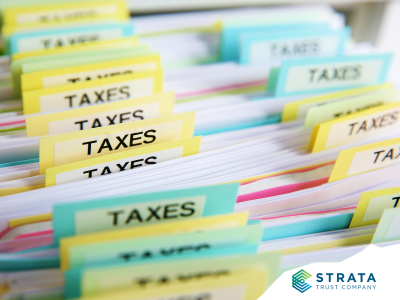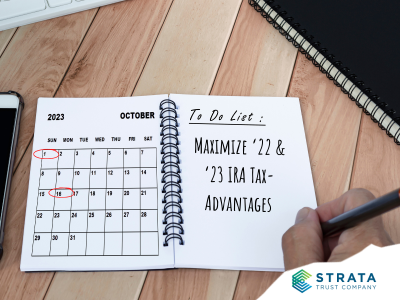As we approach the end of 2023, we may be distracted by other events. Kids and grandkids returning to school, preparing the house and yard for winter, thinking ahead to the holidays: many things compete for our attention. But in the busyness of the season, don’t forget about taking your required minimum distributions (RMDs) from your IRAs or other retirement plans. You must generally take RMDs by December 31 of each year, but your first RMD can be delayed until April 1 of the year following your first distribution year. For STRATA accountholders, RMD requests are due by December 1 in order to meet the December 31 deadline. Below are some details and helpful tips about RMDs.
New SECURE 2.0 Rules
 The SECURE 2.0 Act has made many changes to IRA and qualified plan rules. The most immediate change that affects RMDs is the increase in the age that initially triggers RMDs. Effective for this year, the new RMD age is 73. But be careful – the rules are not always what they seem at first. Here’s an easy way to remember the new rule: if you were born in 1950 or earlier, you operate under the old rule (age 72 or age 70½); if you were born in 1951 or later, the new age is 73 (SECURE 2.0 moves the RMD age back to 75, but that’s not in effect until 2033).
The SECURE 2.0 Act has made many changes to IRA and qualified plan rules. The most immediate change that affects RMDs is the increase in the age that initially triggers RMDs. Effective for this year, the new RMD age is 73. But be careful – the rules are not always what they seem at first. Here’s an easy way to remember the new rule: if you were born in 1950 or earlier, you operate under the old rule (age 72 or age 70½); if you were born in 1951 or later, the new age is 73 (SECURE 2.0 moves the RMD age back to 75, but that’s not in effect until 2033).
- Example: Assume that you turn 73 this year (2023). It would be natural to assume that you will operate under the new “age 73 rule” for this year. But if you are 73 this year, that means that you were 72 last year (2022), and so you were required to take a distribution for last year—when the RMD age was still 72. And you will continue taking RMDs for this year.
| Born | RMD Age | Age Increase Effective | IRS Rule |
|---|---|---|---|
| 1950 or earlier | 72 | 6/1/2019 | SECURE ACT |
| 1951 or later | 73 | 1/1/2023 | SECURE 2.0 |
| 1951 or later | 75 | 1/1/2033 | SECURE 2.0 |
SECURE 2.0 contains another favorable rule for those taking RMD – or perhaps we should say, for those not taking RMDs—when they should. You may know that the previous IRS penalty for not taking an RMD was 50% of what you should have taken and didn’t. The IRS often waived this penalty if the IRA owner had missed the RMD for a good reason. But now the penalty is much smaller: it’s now 25%, but this is reduced to 10% if the RMD is taken (and the penalty paid) within two years after the year in which the RMD should have been taken. This is generally good news for those who fail to take their RMDs. But a big question remains: because of the lower penalty, will the IRS now be more reluctant to waive it?
Liquidity, In-Kind Distributions, and Aggregation
 These three terms can be closely related to figuring out the best way to satisfy your RMDs. Let’s look at each one briefly.
These three terms can be closely related to figuring out the best way to satisfy your RMDs. Let’s look at each one briefly.
Liquidity – This refers to how easy it is to take a current investment and turn it into cash for distribution. With self-directed accounts especially, some investors have much of their assets tied up in illiquid investments. One example is securities that are not publicly traded. But just because you may have assets that are hard to turn into cash doesn’t mean that you don’t have to take an RMD when you reach a certain age. It may be helpful to anticipate your need to take an RMD by arranging to convert some of your assets into cash in order to satisfy your RMD. If you do this in an orderly way—without a last-minute “fire sale”—you may be able to save yourself some headaches and some cash.
In-kind distributions – Rather than liquidating assets, you may be able to simply distribute certain assets in-kind, meaning the asset is not sold within the IRA but is placed in your name outside the IRA. This way you retain the asset, but you satisfy the RMD by distributing the asset from the IRA. You will get an IRS Form 1099-R reflecting the withdrawal, and you will generally have to pay tax on this amount – but you can keep the asset and enjoy future earnings on it outside the IRA.
Aggregation – If you have more than one IRA, you may take the full RMD amount from any combination of your IRAs. Here’s an example:
- Example: You have one self-directed IRA invested primarily in precious metals. Because you want to retain these investments as a hedge against inflation and market fluctuations, you don’t want to liquidate the gold or silver bullion just to meet your RMD obligation. Fortunately, you can satisfy the RMD on this IRA by taking this RMD amount from your other IRA, which holds enough cash (or cash equivalents).
As long as you withdraw the total RMD amount, the IRS doesn’t care which IRA (or IRAs) the distribution comes from. This aggregation approach can spare you from having to sell assets that you would rather keep in your IRAs. Just remember that aggregation cannot be used on qualified plans, such as 401(k) plans.
Qualified Charitable Distributions
 Qualified Charitable Distributions (QCDs) are distributions that are made directly to a charitable organization after IRA owners reach 70½. Annual QCDs cannot exceed $100,000, and any amount paid this way counts toward satisfying the IRA owner’s RMD. The big benefit of QCDs is that they are not included in a taxpayer’s income at all, so they provide a tax benefit without having to itemize deductions. And as of 2023 (under a SECURE 2.0 provision), IRA owners can make a one-time QCD payment to a “split-interest entity” such as a charitable remainder trust. Keep in mind that all the approaches addressed here should be discussed with a financial professional.
Qualified Charitable Distributions (QCDs) are distributions that are made directly to a charitable organization after IRA owners reach 70½. Annual QCDs cannot exceed $100,000, and any amount paid this way counts toward satisfying the IRA owner’s RMD. The big benefit of QCDs is that they are not included in a taxpayer’s income at all, so they provide a tax benefit without having to itemize deductions. And as of 2023 (under a SECURE 2.0 provision), IRA owners can make a one-time QCD payment to a “split-interest entity” such as a charitable remainder trust. Keep in mind that all the approaches addressed here should be discussed with a financial professional.
Roth IRA Conversions
 While RMDs are required for Traditional, SEP, and SIMPLE IRAs, they are not required with Roth IRAs. One way to avoid future RMDs is to convert all or a portion of your other IRAs into a Roth IRA. Of course, this transaction involves paying tax on the previously untaxed part of any converted amount, and this may be a substantial obstacle for many. But the future benefits of Roth IRAs may be worth considering—not simply to avoid RMDs, but to enjoy potentially tax-free distributions. Always seek financial or tax advice before converting assets to a Roth IRA.
While RMDs are required for Traditional, SEP, and SIMPLE IRAs, they are not required with Roth IRAs. One way to avoid future RMDs is to convert all or a portion of your other IRAs into a Roth IRA. Of course, this transaction involves paying tax on the previously untaxed part of any converted amount, and this may be a substantial obstacle for many. But the future benefits of Roth IRAs may be worth considering—not simply to avoid RMDs, but to enjoy potentially tax-free distributions. Always seek financial or tax advice before converting assets to a Roth IRA.
Next Steps
To make sure that STRATA can process your 2023 withdrawal by the IRS deadline, you must request your RMD distribution by December 1, 2023. For more information on RMDs, visit the Required Minimum Distributions page on our SDIRA Knowledge Center. If you have any questions regarding RMDs for your STRATA IRA(s), please contact our self-directed IRA experts.


















